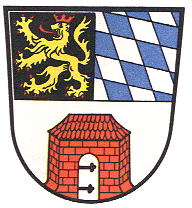Kemnath: Difference between revisions
Knorrepoes (talk | contribs) |
Knorrepoes (talk | contribs) |
||
| Line 21: | Line 21: | ||
===Origin/meaning=== | ===Origin/meaning=== | ||
The oldest seal of the city dates from 1359 and shows a small house, a so called Kemenate, and thus a canting symbol. All small seals until the late 18<sup>th</sup> century only showed the house. Around 1430 a new great seal was made, which showed the house in the base and in the upper half the arms of Pfalz-Bayern (lion and diamonds), to indicate that the city was part of Bayern. As supporter a savage was used. These arms, including the supporter, were used until 1937, when the supporter was removed. | The oldest seal of the city dates from 1359 and shows a small house, a so called Kemenate, and thus a canting symbol. All small seals until the late 18<sup>th</sup> century only showed the house. | ||
Around 1430 a new great seal was made, which showed the house in the base and in the upper half the arms of Pfalz-Bayern (lion and diamonds), to indicate that the city was part of Bayern. As supporter a savage was used. These arms, including the supporter, were used until 1937, when the supporter was removed. | |||
<gallery widths=250px heights=200px perrow=0> | <gallery widths=250px heights=200px perrow=0> | ||
Revision as of 06:05, 27 July 2022
This page is part of the German heraldry portal Deutsche Wappensammlung |
Heraldry of the World |
|
German heraldry:
|
Selected collector's items from Germany:
|
KEMNATH
State : Bayern
District (Kreis) : Tirschenreuth (until 1973 Kemnath)
Additions : 1946 Fortschau; 1972 Atzmannsberg, Guttenberg, Schönreuth, Zwergau; 1975 Kötzersdorf; 1978 Höflas, Waldeck
| German |
Geteilt und oben gespalten; vorne in Schwarz ein rot gekrönter und rot bewehrter goldener Löwe, hinten die bayerischen Rauten; unten in Silber ein rotes Haus mit geschlossenem silbernem Tor. |
| English | No blazon/translation known. Please click here to send your (heraldic !) blazon or translation |
Origin/meaning
The oldest seal of the city dates from 1359 and shows a small house, a so called Kemenate, and thus a canting symbol. All small seals until the late 18th century only showed the house.
Around 1430 a new great seal was made, which showed the house in the base and in the upper half the arms of Pfalz-Bayern (lion and diamonds), to indicate that the city was part of Bayern. As supporter a savage was used. These arms, including the supporter, were used until 1937, when the supporter was removed.
The arms in an album from 1910
The arms by Hupp in the Kaffee Hag albums +/- 1925
Contact and Support
Partners:
Your logo here ?
Contact us
© since 1995, Heraldry of the World, Ralf Hartemink 
Index of the site
Literature : Stadler, 1964-1971, 8 volumes.
















